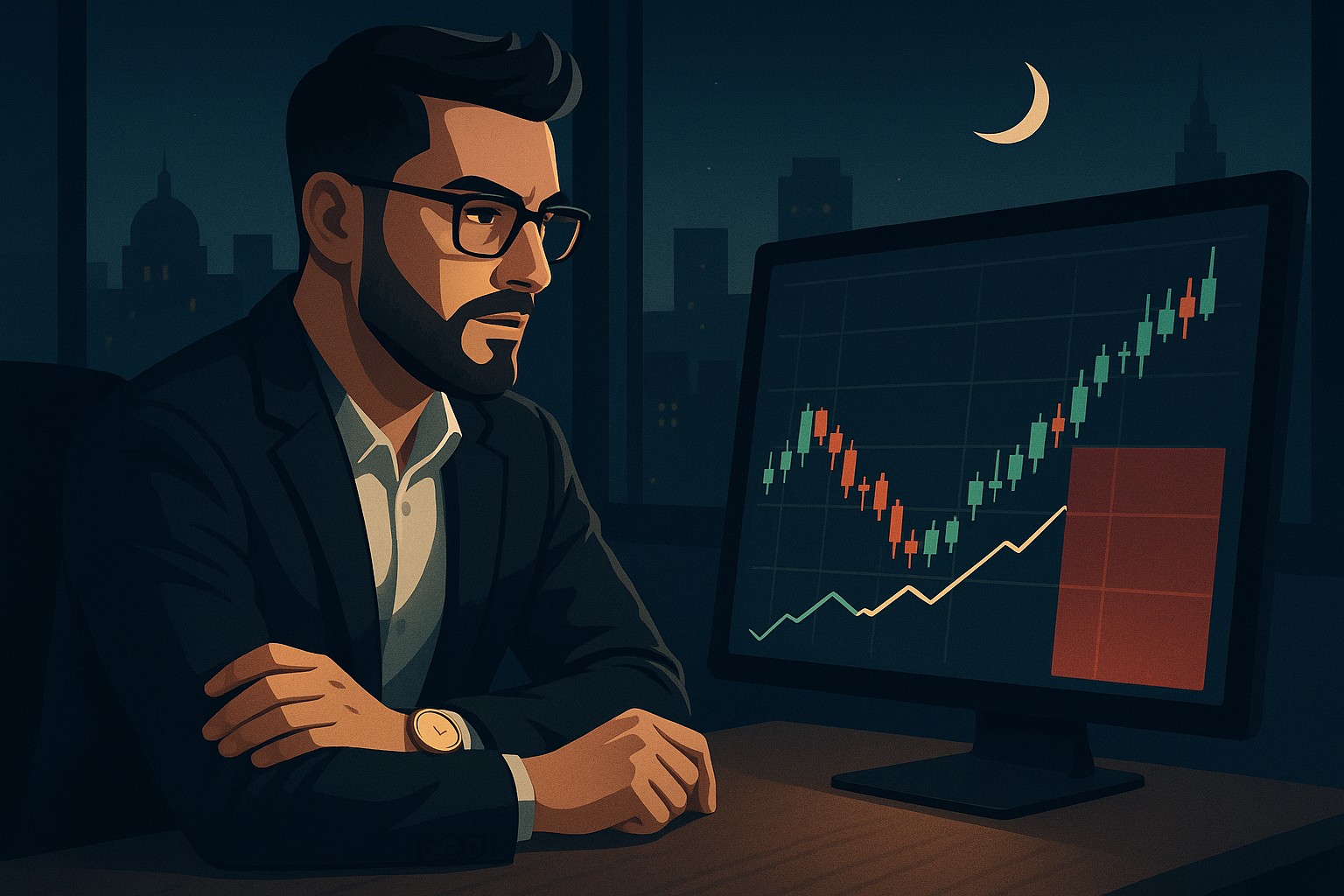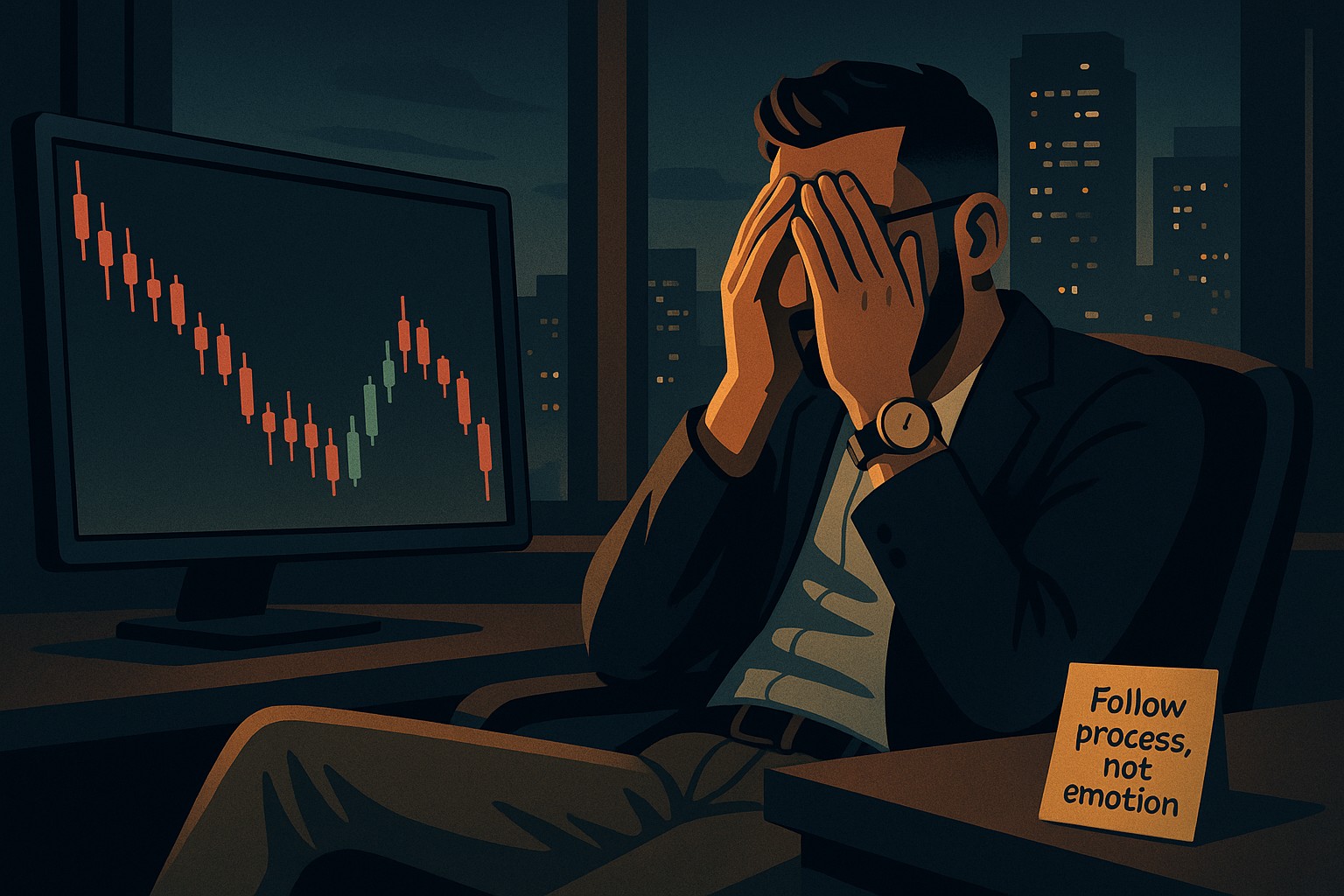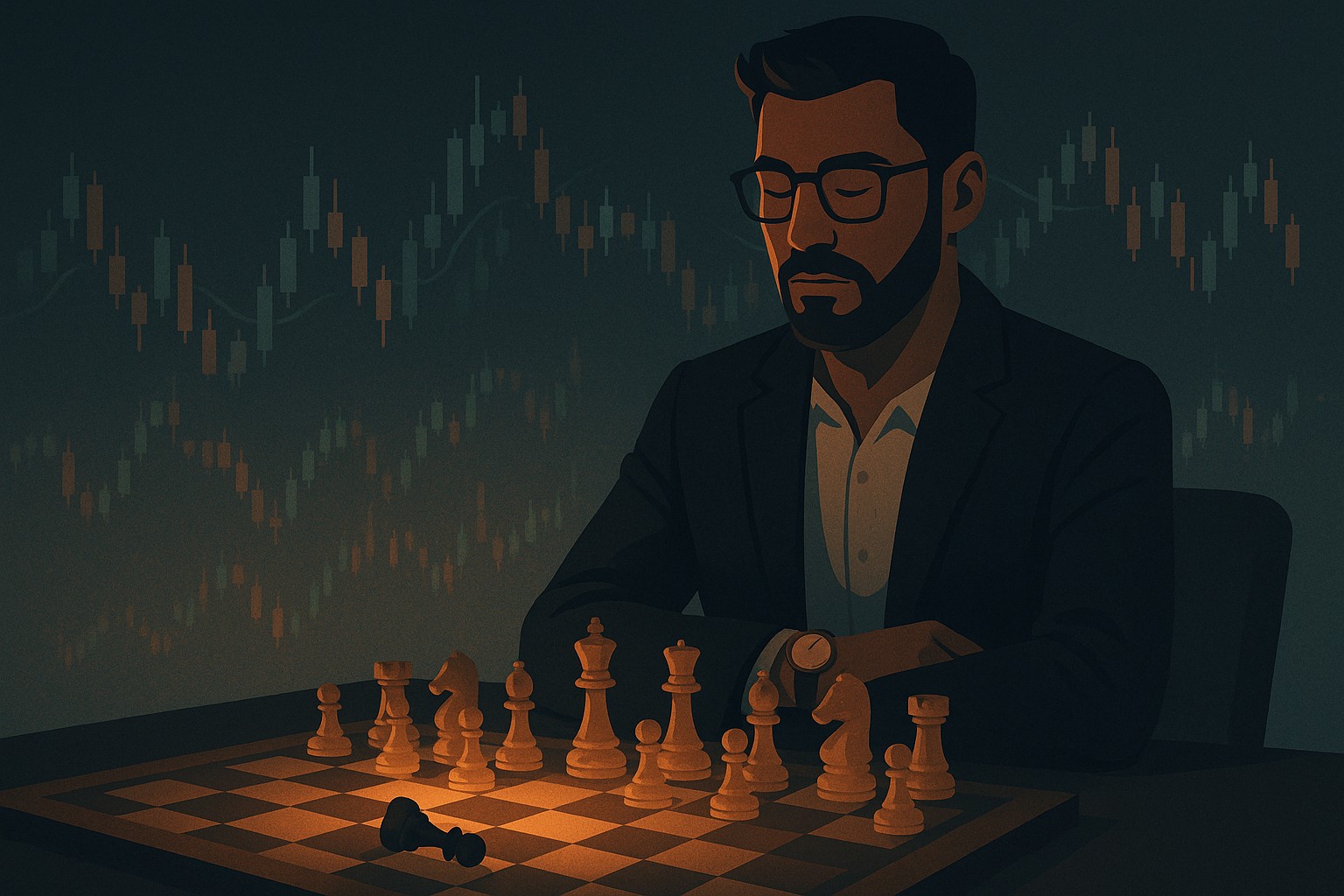The Psychology of Risk Management in Swing Trading
2025-10-14 11:56:46
In swing trading, risk management isn’t just a number - it’s a mirror.
It reflects how well you manage yourself.
Most traders believe risk control is about formulas and lot sizes. But if you’ve ever widened a stop loss because “it’ll come back,” or doubled a position to recover a loss, you already know - risk management is mostly emotional management.
This article explores how your psychology influences every risk decision, and how mastering that inner game can keep you consistent in swing setups where patience and conviction are tested daily.
1. Fear, Greed, and the Risk Spectrum

Every swing setup sits on a spectrum between fear and greed.
Fear whispers, “Take profit now before it reverses.”
Greed replies, “Hold longer - it might go further.”
Both sound logical. Both are traps.
That’s why your plan must exist before emotion enters the trade. As detailed in How to Think Like a Price Action Trader, your mindset should shift from reacting to price to anticipating it - defining invalidation levels and targets before emotions distort judgment.
Understanding market context also helps. When you frame risk inside higher timeframe structure - like in The Power of Multi-Timeframe Analysis in Smart Money Concepts - fear and greed have less room to sway your conviction.
2. The Psychology of Drawdown

Drawdowns don’t just test your account - they test your identity.
A few losses in a row, and suddenly your confidence fractures. You start overanalyzing, second-guessing, or worse, forcing trades to get even.
That spiral is called revenge trading, and it’s the single biggest emotional leak in swing trading. To break the cycle, revisit The Mental Game of Execution - it explains how discipline, not emotion, drives consistent performance.
And when fear of missing out fuels bad decisions, Overcoming FOMO & Revenge Trading offers a practical framework to recognize emotional triggers before they cost you money.
💭 Rule of Alignment: Your emotional stop loss must always match your financial stop loss.
3. Swing Trade Risk Structure: Build a Cushion, Not a Coffin

Unlike scalpers, swing traders ride through news volatility, overnight gaps, and weekend risk.
The solution? Build your structure first, then size your trade.
Using concepts from Mastering Price Action at Key Levels, you can anchor stop-losses to meaningful structure instead of arbitrary points. This protects you from emotional interference mid-trade.
If you prefer to re-enter after breakouts without chasing, Mastering Retests: How to Enter with Confirmation After a Breakout shows how to confirm setups with precision - and without impulsive sizing errors.
That’s why risk planning must extend beyond the chart.
A strong swing setup typically risks 1–1.5% of capital per position, with a stop loss placed beyond structure - not emotion.
But here’s the twist: your confidence in holding depends more on your mental margin than your account margin.
Before the trade:
- Predefine your stop and position size.
- Accept the loss emotionally before pressing “buy.”
- Journal what invalidates your bias - not what confirms it.
Doing this keeps you objective when the market pulls back - and trust me, it will.
4. The Risk Illusion: When “Small” Feels Big

Here’s where psychology distorts math.
Two traders both risk 1% - one feels calm, the other panics. Why?
Because risk perception isn’t about numbers. It’s about attachment.
If you trade rent money, 1% feels like 100%.
If you overtrade, 1% across five correlated setups becomes 5%.
If you check your trades every five minutes, 1% volatility feels like a heart attack.
So, when designing your swing trading plan, consider contextual risk - not just technical risk.
That’s why understanding your risk of ruin is crucial. As outlined in Risk of Ruin in Trading – Respect the Math of Survival, even a few impulsive over-leveraged trades can erase weeks of disciplined execution.
It’s not the loss that kills traders - it’s how quickly small losses snowball into identity crises.
You’re not managing trades; you’re managing your nervous system.
5. Mindful Risk Management: The Calm Within Volatility

Professional traders don’t avoid volatility - they train through it.
Instead of panicking, they regulate.
Try this before every swing trade:
- Name your emotion before you click “buy.”
- State your worst-case loss aloud and accept it.
- Set alerts, then step away from the screen.
This process transforms risk from a threat into a routine. And if you’re still learning to balance patience with structure, revisit Introduction to Swing Trading for rhythm-based setups that naturally reduce emotional volatility.
Real-Life Analogy: The Chess Player’s Patience

A chess grandmaster doesn’t panic when a pawn is lost - he’s thinking five moves ahead.
Swing trading is no different. A single losing trade doesn’t define you; your sequence of decisions does.
Every move must serve your endgame: capital preservation and mental equilibrium.
Final Thoughts

At the end of the day, risk management is more than just the numbers in your trading plan - it’s a reflection of how well you manage yourself when the market tests your nerves.
You can master chart patterns, Smart Money Concepts, or multi-timeframe setups, but if your emotions hijack your discipline, every advantage fades.
Swing trading, by nature, rewards patience and composure. You’re holding trades through noise, headlines, and uncertainty - a mental game that separates the seasoned from the reactive.
So treat your psychology as part of your system. The same way you study structure or refine entries, study your emotional tendencies: where fear takes over, when greed whispers, and how doubt disguises itself as logic.
If you can manage your emotional volatility as well as you manage your technical risk, you won’t just survive - you’ll compound consistency.
Because in trading, mastery isn’t found in predicting the next move.
It’s found in staying calm when everyone else panics.
FAQs
How can I reduce fear when holding swing trades overnight?
Start small. Reducing position size lowers stress. For a structured framework, study Mastering Position Sizing to align technical risk with your emotional comfort zone.
What’s the ideal risk per trade for swing traders?
Typically 1–1.5% per trade. You’ll find examples in How Much Should You Risk per Trade? - a must-read if you’re aiming for steady compounding without overexposure.
Why do I panic even when my risk is small?
Because your psychological tolerance hasn’t caught up with your technical sizing. The article Mastering Fear in Trading explains how to convert anxiety into protective awareness instead of avoidance.
Can journaling help improve emotional risk control?
Absolutely. Tracking emotional states and outcomes helps identify triggers. Start with Trading Journal & Reflection – The Trader’s Mirror - it turns self-awareness into strategy.
Start Practicing with Confidence - Risk-Free!
- Trade forex, indices, gold, and more
- Access ACY, MT4, MT5, & Copy Trading Platforms
- Practice with zero risk
It’s time to go from theory to execution - risk-free.
Create an Account. Start Your Free Demo!
Check Out My Contents:
Strategies That You Can Use
Looking for step-by-step approaches you can plug straight into the charts? Start here:
- How To Trade & Scalp Indices at the Open Using Smart Money Concepts (SMC)
- How to Trade Breakouts Effectively in Day Trading with Smart Money Concepts
- Complete Step-by-Step Guide to Day Trading Gold (XAU/USD) with Smart Money Concepts (SMC)
- The Power of Multi-Timeframe Analysis in Smart Money Concepts (SMC)
- Forex Trading Strategy for Beginners
- Mastering Candlestick Pattern Analysis with the SMC Strategy for Day Trading
- How to Use Fibonacci to Set Targets & Stops (Complete Guide)
- RSI Divergence Trading Strategy for Gold: How to Identify and Trade Trend Reversals
- Stochastics Trading Secrets: How to Time Entries in Trending Markets using Stochastics
- Gold Trading Stochastics Strategy: How to Trade Gold with 2R - 3R Targets
- RSI Hidden Divergence Explained: How to Spot Trend Continuations Like a Pro
- Moving Averages Trading Strategy Playbook
- Mastering Fibonacci Trading Psychology - Trusting the Levels, Managing the Mind
- Mastering Price Action at Key Levels - How to Spot, Trade, and Win at the Most Crucial Zones
- Mastering Retests: How to Enter with Confirmation After a Breakout
Indicators / Tools for Trading
Sharpen your edge with proven tools and frameworks:
- The Ultimate Guide to Risk Management in Trading - A Complete Compilation for 2025
- Moving Averages Trading Strategy Playbook
- How to Think Like a Price Action Trader
- Mastering Fibonacci Trading Psychology - Trusting the Levels, Managing the Mind
How To Trade News
News moves markets fast. Learn how to keep pace with SMC-based playbooks:
- Why Smart Money Concepts Work in News-Driven Markets - CPI, NFP, and More
- How to Trade NFP Using Smart Money Concepts (SMC)-A Proven Strategy for Forex Traders
- How to Trade CPI Like Smart Money - A Step-by-Step Guide Using SMC
Learn How to Trade US Indices
From NASDAQ opens to DAX trends, here’s how to approach indices like a pro:
- How to Start Trading Indices and Get into the Stock Market with Low Capital (2025 Guide)
- Best Indices to Trade for Day Traders | NASDAQ, S&P 500, DAX + Best Times to Trade Them
- How To Trade & Scalp Indices at the Open Using Smart Money Concepts (SMC)
- NAS100 - How to Trade the Nasdaq Like a Pro (Smart Money Edition)
How to Start Trading Gold
Gold remains one of the most traded assets - - here’s how to approach it with confidence:
- How to Swing Trade Gold (XAU/USD) Using Smart Money Concepts: A Simple Guide for Traders
- Complete Step-by-Step Guide to Day Trading Gold (XAU/USD) with Smart Money Concepts (SMC)
- The Ultimate Guide to Backtesting and Trading Gold (XAU/USD) Using Smart Money Concepts (SMC)
- Why Gold Remains the Ultimate Security in a Shifting World
- How to Exit & Take Profits in Trading Gold Like a Pro: Using RSI, Range Breakdowns, and MAs as Your Confluence
How to Trade Japanese Candlesticks
Candlesticks are the building blocks of price action. Master the most powerful ones:
- Mastering the Top Japanese Candlesticks: The Top 5 Candlesticks To Trade + Top SMC Candlestick Pattern
- How to Trade Candlestick Patterns with High Probability: A Complete Guide for Beginners
- The Top Japanese Candlestick Guide: What is an Engulfing Pattern and How to Trade It?
- Piercing Pattern Candlestick Explained: How to Trade It - Step-By-Step Guide
- Morning & Evening Star Candlestick Patterns - How to Trade Market Reversals with Confidence
How to Start Day Trading
Ready to go intraday? Here’s how to build consistency step by step:
- 5 Steps to Start Day Trading: A Strategic Guide for Beginners
- 8 Steps How to Start Forex Day Trading in 2025: A Beginner’s Step-by-Step Guide
- 3 Steps to Build a Trading Routine for Consistency and Discipline - Day Trading Edition
- The Ultimate Guide to Understanding Market Trends and Price Action
- Trading with Momentum: The Best Trading Session to Trade Forex, Gold and Indices
Learn how to navigate yourself in times of turmoil
Markets swing between calm and chaos. Learn to read risk-on vs risk-off like a pro:
- How to Identify Risk-On and Risk-Off Market Sentiment: A Complete Trader’s Guide
- How to Trade Risk-On and Risk-Off Sentiment - With Technical Confirmation
- The Ultimate Guide to Understanding Market Trends and Price Action
Want to learn how to trade like the Smart Money?
Step inside the playbook of institutional traders with SMC concepts explained:
- Why Smart Money Concepts Work: The Truth Behind Liquidity and Price Action
- Mastering the Market with Smart Money Concepts: 5 Strategic Approaches
- Understanding Liquidity Sweep: How Smart Money Trades Liquidity Zones in Forex, Gold, US Indices
- The SMC Playbook Series Part 1: What Moves the Markets? Key Drivers Behind Forex, Gold & Stock Indices
- The SMC Playbook Series Part 2: How to Spot Liquidity Pools in Trading-Internal vs External Liquidity Explained
- Fair Value Gaps Explained: How Smart Money Leaves Footprints in the Market
- Accumulation, Manipulation, Distribution: The Hidden Cycle That Runs Every Market
- Institutional Order Flow - Reading the Market Through the Eyes of the Big Players
- London Session Trading Secrets: How Smart Money Sets the High & Low of the Day
- Mastering the New York Session - Smart Money Concepts Guide
Master the World’s Most Popular Forex Pairs
Forex pairs aren’t created equal - - some are stable, some are volatile, others tied to commodities or sessions.
- The Top 5 All-Time Best Forex Pairs to Trade
- Top Forex Pairs Beyond the Big Five
- EUR/USD: The King of Forex
- USD/JPY: The Fast Mover
- GBP/USD: The Volatile Cable
- AUD/USD: The Commodity Currency
- USD/CAD: The Oil-Backed Pair
- GBP/JPY: How to Trade The Beast
- Asian & London Session Secrets
- Mastering the New York Session
Stop Hunting 101
If you’ve ever been stopped out right before the market reverses - - this is why:
- Stop Hunting 101: How Swing Highs and Lows Become Liquidity Traps
- Outsmarting Stop Hunts: The Psychology Behind the Trap
- How to Lessen Risk From Stop Hunts in Trading
- How Stop Hunts Trigger Revenge Trading - Breaking the Pain Cycle
- How to Accept Stop Hunts Without Losing Discipline - Shifting From Frustration to Focus
Trading Psychology
Mindset is the deciding factor between growth and blowups. Explore these essentials:
- The Mental Game of Execution - Debunking the Common Trading Psychology
- Managing Trading Losses: Why You Can Be Wrong and Still Win Big in Trading
- The Hidden Threat in Trading: How Performance Anxiety Sabotages Your Edge
- Why 90% of Retail Traders Fail Even with Profitable Trading Strategies
- Top 10 Habits Profitable Traders Follow Daily to Stay Consistent
- Top 10 Trading Rules of the Most Successful Traders
- Top 10 Ways to Prevent Emotional Trading and Stay Disciplined in the Markets
- Why Most Traders Fail - Trading Psychology & The Hidden Mental Game
- Emotional Awareness in Trading - Naming Your Triggers
- Discipline vs. Impulse in Trading - Step-by Step Guide How to Build Control
- Trading Journal & Reflection - The Trader’s Mirror
- Overcoming FOMO & Revenge Trading in Forex - Why Patience Pays
- Risk of Ruin in Trading - Respect the Math of Survival
- Identity-Based Trading: Become Your Trading System for Consistency
- Trading Psychology: Aligning Emotions with Your System
- Mastering Fear in Trading: Turn Doubt into a Protective Signal
- Mastering Greed in Trading: Turn Ambition into Controlled Growth
- Mastering Boredom in Trading: From Restless Clicking to Patient Precision
- Mastering Doubt in Trading: Building Confidence Through Backtesting and Pattern Recognition
- Mastering Impatience in Trading: Turn Patience Into Profit
- Mastering Frustration in Trading: Turning Losses Into Lessons
- Mastering Hope in Trading: Replacing Denial With Discipline
- When to Quit on Trading - Read This!
- The Math of Compounding in Trading
- Why Daily Wins Matter More Than Big Wins
- Scaling in Trading: When & How to Increase Lot Sizes
- Why Patience in Trading Fuels the Compounding Growth
- Step-by-Step Guide on How to Manage Losses for Compounding Growth
- The Daily Habits of Profitable Traders: Building Your Compounding Routine
- Trading Edge: Definition, Misconceptions & Casino Analogy
- Finding Your Edge: From Chaos to Clarity
- Proving Your Edge: Backtesting Without Bias
- Forward Testing in Trading: How to Prove Your Edge Live
- Measuring Your Edge: Metrics That Matter
- Refining Your Edge: Iteration Without Overfitting
- The EDGE Framework: Knowing When and How to Evolve as a Trader
- Scaling Your Edge: From Small Account to Consistency
Market Drivers
- Central Banks and Interest Rates: How They Move Your Trades
- Inflation & Economic Data: CPI Trading Strategy and PPI Indicator Guide
- Geopolitical Risks & Safe Havens in Trading (Gold, USD, JPY, CHF)
- Jobs, Growth & Recession Fears: NFP, GDP & Unemployment in Trading
- Commodities & Global Trade: Oil, Gold, and Forex Explained
- Market Correlations & Intermarket Analysis for Traders
Swing Trading 101
- Introduction to Swing Trading
- The Market Basics for Swing Trading
- Core Principles of Swing Trading
- The Technical Foundations Every Swing Trader Must Master
- Swing Trader’s Toolkit: Multi-Timeframe & Institutional Confluence
Risk Management
The real edge in trading isn’t strategy - it’s how you protect your capital:
- Mastering Risk Management: Stop Loss, Take Profit, and Position Sizing
- Why Risk Management Is the Only Edge That Lasts
- How Much Should You Risk per Trade? (1%, 2%, or Less?)
- The Ultimate Risk Management Plan for Prop Firm Traders - Updated 2025
- Mastering Position Sizing: Automate or Calculate Your Risk Like a Pro
- Martingale Strategy in Trading: Compounding Power or Double-Edged Sword?
- How to Add to Winners Using Cost Averaging and Martingale Principle with Price Confirmation
Suggested Learning Path
If you’re not sure where to start, follow this roadmap:
- Start with Trading Psychology → Build the mindset first.
- Move into Risk Management → Learn how to protect capital.
- Explore Strategies & Tools → Candlesticks, Fibonacci, MAs, Indicators.
- Apply to Assets → Gold, Indices, Forex sessions.
- Advance to Smart Money Concepts (SMC) → Learn how institutions trade.
- Specialize → Stop Hunts, News Trading, Turmoil Navigation.
This way, you’ll grow from foundation → application → mastery, instead of jumping around randomly.
Follow me for more daily market insights!
Jasper Osita - LinkedIn - FXStreet - YouTube
This content may have been written by a third party. ACY makes no representation or warranty and assumes no liability as to the accuracy or completeness of the information provided, nor any loss arising from any investment based on a recommendation, forecast or other information supplies by any third-party. This content is information only, and does not constitute financial, investment or other advice on which you can rely.
Try These Next
4 Powerful Tactics to Overcome the Most Costly Forex Mistakes
How to Master MT4 & MT5 - Tips and Tricks for Traders
The Importance of Fundamental Analysis in Forex Trading
Forex Leverage Explained: Mastering Forex Leverage in Trading & Controlling Margin
The Importance of Liquidity in Forex: A Beginner's Guide
Close All Metatrader Script: Maximise Your Trading Efficiency and Reduce Stress
Best Currency Pairs To Trade in 2025
Forex Trading Hours: Finding the Best Times to Trade FX
MetaTrader Expert Advisor - The Benefits of Algorithmic Trading and Forex EAs
Top 5 Candlestick Trading Formations Every Trader Must Know















